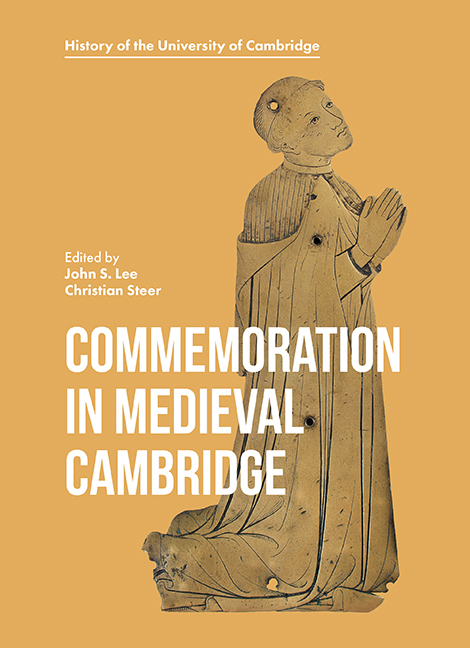Book contents
- Frontmatter
- Contents
- List of Illustrations
- Acknowledgements
- List of Contributors
- Abbreviations
- Introduction: In Fellowship with the Dead
- 1 Monuments and Memory: A University Town in Late Medieval England
- 2 The Commemoration of the Living and the Dead at the Friars Minor of Cambridge
- 3 The City of London and the Founding of the Guild of Corpus Christi
- 4 Patrons and Benefactors: The Masters of Trinity Hall in the Later Middle Ages
- 5 A Comparison of Academical and Legal Costume on Memorial Brasses
- 6 Commemoration at a Royal College
- 7 Cambridge Commemorations of Lady Margaret Beaufort's Household
- 8 ‘The Stones are all disrobed’: Reasons for the Presence and Absence of Monumental Brasses in Cambridge
- Bibliography
- Index
8 - ‘The Stones are all disrobed’: Reasons for the Presence and Absence of Monumental Brasses in Cambridge
Published online by Cambridge University Press: 25 October 2019
- Frontmatter
- Contents
- List of Illustrations
- Acknowledgements
- List of Contributors
- Abbreviations
- Introduction: In Fellowship with the Dead
- 1 Monuments and Memory: A University Town in Late Medieval England
- 2 The Commemoration of the Living and the Dead at the Friars Minor of Cambridge
- 3 The City of London and the Founding of the Guild of Corpus Christi
- 4 Patrons and Benefactors: The Masters of Trinity Hall in the Later Middle Ages
- 5 A Comparison of Academical and Legal Costume on Memorial Brasses
- 6 Commemoration at a Royal College
- 7 Cambridge Commemorations of Lady Margaret Beaufort's Household
- 8 ‘The Stones are all disrobed’: Reasons for the Presence and Absence of Monumental Brasses in Cambridge
- Bibliography
- Index
Summary
The university city of Oxford, with its twenty-one pre-nineteenth-century colleges and fourteen medieval parish churches, is blessed with a rich patrimony of monumental brasses. There are no fewer than 117 pre-eighteenth-century brasses and evidence in the form of either indents or antiquarian records of a further 326. Cambridge is less fortunate. The County Series volume lists forty-one surviving brasses and evidence of at least 152 lost ones. Why should this be? One obvious reason is that Oxford was always a larger community. Cambridge only has sixteen pre-nineteenth-century colleges. A good measure of relative size is that Alfred Emden's list of pre-1500 members of the University of Cambridge runs to 695 pages, whereas the Oxford equivalent requires 2,242 pages.
Cambridge before the University was shaped by its strategic position at a river crossing, commanding a network of roads and providing access to the Fenland waterways. It was a mint town from the reign of Edgar and at the time of Domesday Book had at least 373 house plots (compared with 946 in Oxford). Its location encouraged its development as a trading centre; from 1211 Cambridge was the home of one of the major English fairs: Stourbridge Fair. In the thirteenth century there were sixteen parishes in Cambridge, but of these one did not survive the depopulation of the Black Death and another was redeveloped out of existence when King's was founded. By 1279 there were almost 550 occupied house plots, together with seventy-five shops, suggesting a total population of four to five thousand. As early as 1329 a townsman, Eudo de Helpringham, was commemorated by a brass. The late medieval civic elite provided a significant clientele for marblers, as can be seen on the floors of Great St. Mary's (St. Mary's in the Market), the main town church, and St. Edward's (Plate 18). Although there are difficulties in assessing the total population from the 1524–25 lay subsidies, estimates of 3,900 and 4,600 have been proposed, of which approximately 1,300 were members of the University. The development of Cambridge as a university town thus alleviated the effects of late medieval population decline.
- Type
- Chapter
- Information
- Commemoration in Medieval Cambridge , pp. 152 - 164Publisher: Boydell & BrewerPrint publication year: 2018



